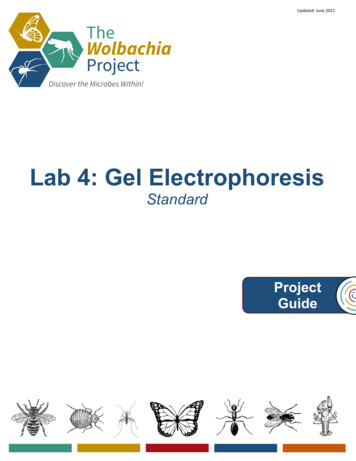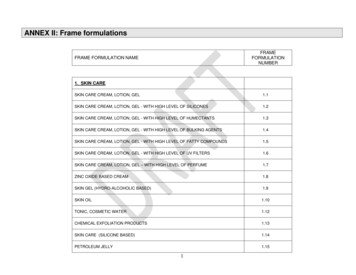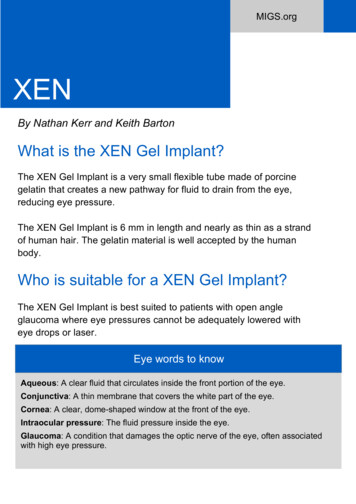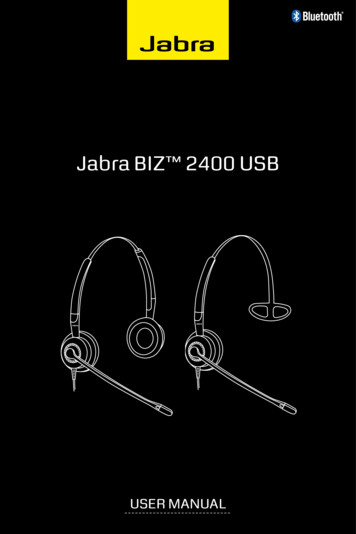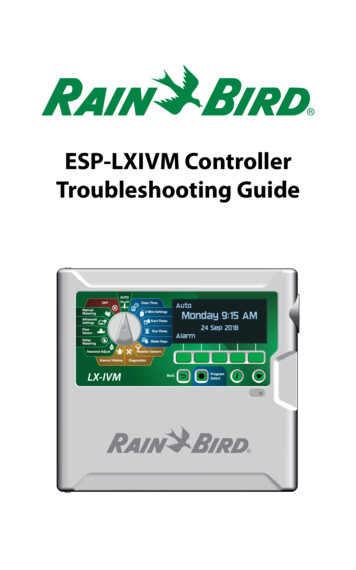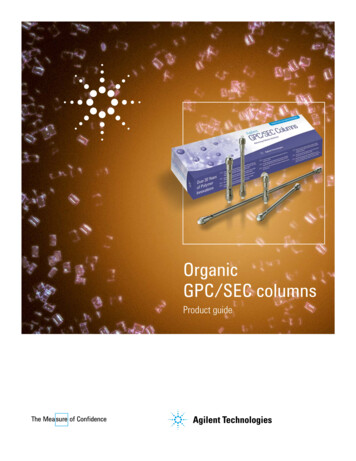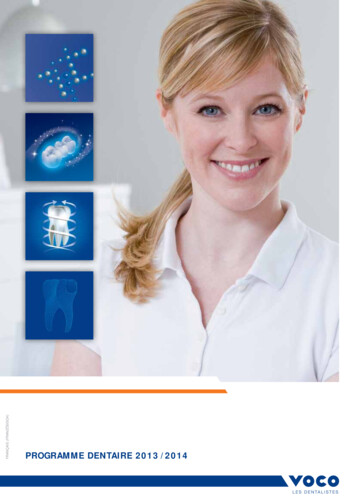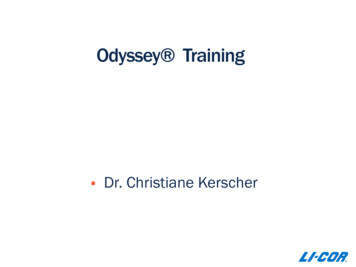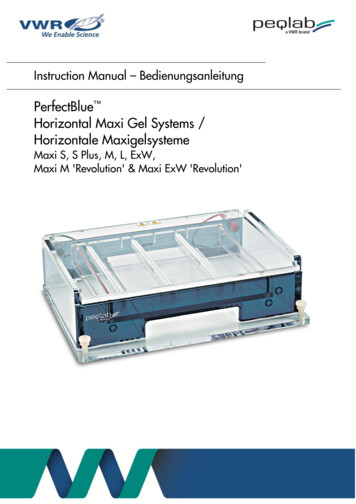
Transcription
Instruction Manual – BedienungsanleitungPerfectBlue Horizontal Maxi Gel Systems /Horizontale MaxigelsystemeMaxi S, S Plus, M, L, ExW,Maxi M 'Revolution' & Maxi ExW 'Revolution'
Instruction Manual PerfectBlue Horizontal Maxi Gel SystemsCONTENTSWARRANTY2PACKAGING LIST2SAFETY PRECAUTIONS2SYSTEM OVERVIEW3Technical properties3GENERAL INSTRUCTIONS4Setting up the system and pouring the agarose gelLoading of samples and electrophoresisVisualisationCleaningREQUIRED REAGENTS & RECIPES45567Electrophoresis buffersAgarose: Gel volumes and percentageEthidium bromideLoading buffer/Sample bufferMolecular weight marker78899TROUBLESHOOTING9TECHNICAL SUPPORT AND ORDERING INFORMATION11PerfectBlue Maxi SPerfectBlue Maxi M & Maxi M 'Revolution'PerfectBlue Maxi LPerfectBlue Maxi ExW & Maxi ExW 'Revolution'Power SuppliesAgaroses111113131414LITERATUREVWR v0617 E151
Instruction Manual PerfectBlue Horizontal Maxi Gel SystemsWARRANTYVWR guarantees that the horizontal electrophoresis system you have received has been thoroughly tested and meets its published specification.However, immediately upon arrival, please check carefully that the shipment is complete and has notbeen damaged in transit. For missing parts or to report any kind of damage, please contact VWR (see'TECHNICAL SUPPORT AND ORDERING INFORMATIONS'). Please retain all packaging materials untilthe delivery has been completely checked since this will speed up the return of goods if required andreduce environmental impact. Any form of returns, replacements or credit notes must be agreed in advance by VWR.For the complete range of PerfectBlue electrophoresis and blotting systems, VWR guarantees a warranty period of 36 months if the products have been used solely according to the instruction manual unlessa different warranty has been offered in writing. No liability is accepted for loss or damage arising fromincorrect use. VWR's liability is limited to the repair or replacement of the unit or refund of the purchaseprice, at VWR's discretion. VWR is not liable for any consequential damages. After the warranty periodhas expired VWR can offer repairs.VWR reserves the right to alter the technical specifications of the PerfectBlue electrophoresis or blottingsystems without prior notice. This will enable us to implement developments as soon as they arise.PACKAGING LISTUnless requested otherwise, the following items are included in shipment for the models Maxi S, Maxi SPlus, Maxi M, Maxi M 'Revolution', Maxi L, Maxi ExW and Maxi ExW 'Revolution':one buffer chamber with corrosion-protected platinum electrodesone safety lid with attached power cordsone UV-transmissible gel tray and two End GatesMaxi S: 3 combs, 1.5 mm thick, 12, 16 and 20 teethMaxi S Plus: 3 combs, 1.5 mm thick, 10, 17 and 34 teethMaxi M ('Revolution'): 3 combs, 1.5 mm thick, 16, 24 and 36 teethMaxi L: 4 combs, 1.5 mm tick, 2 each 25 and 50 teethMaxi ExW ('Revolution'): 4 combs, 1.5 mm thick, 2 each 25 and 50 teethUser ManualSAFETY PRECAUTIONSPlease, read this Instruction Manual carefully before using the gel system.Only use a CE marked DC power supply.Always disconnect the gel system from the power supply before removing the safety lid.Always disconnect the gel system from the power supply when it is not in use or before moving it.Running conditions for this unit should not exceed the maximum operating voltage or current.Do not fill the chamber with running buffer above the maximum fill line.VWR v0617 E2
Instruction Manual PerfectBlue Horizontal Maxi Gel SystemsSYSTEM OVERVIEWThe horizontal electrophoresis systems PerfectBlue Maxi S, Maxi S Plus, Maxi M ('Revolution'), Maxi Land Maxi ExW ('Revolution') are designed for the separation of medium to high sample numbers atlong distances and provide flat, even banding patterns and consistent results. The gel trays are sealedinside the chamber by using End Gates included in delivery. These gasketed End Gates are specificallyengineered to fit accurately into the gel tray grooves eliminating the need to tape or seal the tray beforepouring gels. Utilizing the built-in leveling feature in all of the horizontal Maxi Gel Systems allows theuser to cast level gels quickly. Four gel sizes are available to provide maximum versatility. Dependingon the specific model, the UV-transmissible gel trays are equipped with 4 to 12 comb slots so that youcan run multiple sample sets to equal distances simultaneously.VWR offers a wide variety of standard and microtiter combs in two different thicknesses (1 mm or 1.5mm). Microtiter combs allow for speedy sample loading using a multi-channel pipette. Additional preparative combs for large sample volumes and wall combs and casting dams to cast gels in smaller sizesare available for increased versatility. For dividing up the gel tray, wall combs are put in the gel tray'sslots instead of a common comb but should get sealed using agarose of higher percentage before casting the gel. Casting dams can be inserted at any position into the gel tray. Due to the optimal fitting andthe heat conductance of the material neither adhesive tape nor concentrated agarose is required forsealing by using the casting dams.For detailed information on available accessories visit www.de.vwr.com or see 'TECHNICAL SUPPORTAND ORDERING INFORMATION'.The Maxi M 'Revolution' and Maxi ExW'Revolution' models are equipped with an internal buffer recirculation system. A trapping system captures hydrogen bubbles which are produced at the cathode due to electrolysis, anddirects them through an ascending tube to theopposing side of the buffer chamber where theanode is located. During this hydrogen bubblemigration, the buffer circulates, preventing thecreation of detrimental pH or ion gradients.Schematic drawing: 'Revolution'-TechnologyTechnical propertiesPerfectBlue Cat. No.Gel size (W xL)Buffer volumeVoltageCurrentTime requiredMaxi SPEQL41-132513 x 25 cm1600 ml20 - 250 V 1 - 150 mA60 - 120 minMaxi S PlusPEQL41-152515 x 25 cm1800 ml20 - 250 V 1 - 150 mA60 - 120 minMaxi MPEQL41-202520 x 25 cm2300 ml20 - 250 V 1 - 150 mA60 - 240 minMaxi M 'Revolution' PEQL41-2025R20 x 25 cm2000 ml20 - 250 V 1 - 150 mA60 - 360 minMaxi LPEQL41-234023 x 40 cm4500 ml20 - 250 V 1 - 150 mA60 - 360 minMaxi ExWPEQL41-232523 x 25 cm3000 ml20 - 250 V 1 - 150 mA60 - 240 minMaxi ExW'Revolution'PEQL41-2325R23 x 25 cm2800 ml20 - 250 V 1 - 150 mA60 - 360 minVWR v0617 E3
Instruction Manual PerfectBlue Horizontal Maxi Gel SystemsGENERAL INSTRUCTIONSSetting up the system and pouring the agarose gel1. Remove the lid from the gel box by holding the front of the buffer chamber with one hand and pulling the lid off by holding the center of the back of the lid.2. Slide the gasketed End Gates into the outermost grooves on either side of the gel tray. The EndGates should be inserted tightly into the grooves with the gasket side facing out. Insert the sealed geltray into the buffer chamber and level the system by using the integrated three-point adjustable leveling platform with bubble level.Optional: The gel tray can be subdivided by a wall comb available as an accessory to pour shortergels. The wall comb should be sealed with 2 % agarose before pouring the real gel.Alternatively, a casting dam available as accessory can be used for this purpose. This aluminum barcan be inserted at any position into the gel tray. Due to the optimal fitting and the heat conductanceof the material neither adhesive tape nor concentrated agarose is required for sealing by using thecasting dams.3. Use electrophoresis-grade agarose and compatible electrophoresis buffer to prepare the gel. Thepercentage of agarose and the buffer to be used is determined by the size of the samples to be separated and further recovery of the samples (see 'REQUIRED REAGENTS & RECIPES'). The agaroseand buffer are mixed and heated over a heat plate by stirring or in a microwave oven until theagarose is completely dissolved.4. The prepared gel then must be cooled to below 60 C before casting to avoid warping the UVT geltray due to excessive heat. If numerous gels are to be run in one day, a large volume of gel may beprepared and be placed in a covered bottle stored 60 C in a water bath.5. Pour or pipette the measured amount (see 'Agarose: Gel volumes and percentage') of warmagarose ( 60 C) onto the UVT gel tray that has been placed into the correct position in the gelbox. Immediately after pouring, insert the desired comb or combs into the comb slots to form thesample wells. Standard agarose should solidify completely in about 30 minutes. If low meltingagarose or a specialty agarose is used, please consult the instructions that came with the product.VWR v0617 E4
Instruction Manual PerfectBlue Horizontal Maxi Gel SystemsLoading of samples and electrophoresis1. Once the gel is completely solidified, remove the End Gates by carefully lifting out of the tray.2. Pour enough compatible running buffer into the unit to fill chamber and completely cover and submerge the gel. A 'Fill Line' is located on each unit to clearly mark the correct buffer level. See'Technical properties' for approximate buffer volumes needed for your unit. Too little buffer maycause the gel to dry out during the run, while excess buffer may slow DNA migration in the gel, increase heat build-up and cause distorted bands.3. Carefully remove the comb (or combs) by tapping lightly to loosen, and slowly lift straight up out ofthe gel tray to avoid damage to the wells.4. Load prepared samples into the wells. Samples should be mixed with a sample loading buffer (giving weight to the samples so that they drop evenly into the wells), and contain tracking dye to monitor the gel run. For details on approximate well volumes see 'TECHNICAL SUPPORT & ORDERINGINFORMATION'. If microtiter combs have been used wells can be loaded by a multi channel pipette. Wells that have been cast with microtiter combs of 26 teeth or less can be loaded 'directly',i.e. the pipette tips fit sequentially into the gel wells. For gels prepared with microtiter combs withmore than 26 teeth the wells can be loaded 'shifted', i.e. the pipette tips fit only into every secondwell.NOTE: It is wise to always run a sample lane of a known 'standard ladder' to determine concentration and size of separated fragments after the gel run, and to aid in photo documentation and analysis.5. Carefully slide the lid with attached power cords onto the unit. This will connect the power cords tothe banana plugs to complete the circuit. Plug the other end of the power cords (4 mm, male) intoan appropriate power supply.Take care to the proper orientation of the electrical field. Remember that nucleic acids are negativelycharged in an alkaline to neutral surrounding and therefore will migrate to the positively chargedanode. In general the color coding for positively charged electrodes is 'red'.6. Turn on the power supply and run the gel at the appropriate voltage/current (see 'Technical properties'). You can observe the progress of electrophoresis by the visual migration of the loading dye.Note that in 0.5 x TBE gels, bromophenol blue co-migrates at 300 bp and xylene cyanol at 4 kbpwith the DNA fragments.VWR v0617 E5
Instruction Manual PerfectBlue Horizontal Maxi Gel SystemsVisualizationWhen the tracking dye has migrated as far through the gel as desired, or to the end of the gel, turn offthe power supply and slide off the lid to disconnect from the power source. Carefully remove the traycontaining the gel (wear gloves). The UV-transmissible gel tray makes for simple visualization and photography with a UV light source without the need to remove the gel from the tray. The gel tray may beplaced back into the casting chamber for convenient transport to the darkroom and to avoid damage tothe gel.CleaningThe buffer chamber, tray, combs and End Gates should be rinsed under warm running water after eachuse. Use a mild detergent to get rid of any debris. A following short rinse off with distilled water prevents the formation of salt marks. It is recommended to allow the chamber to air dry rather than dryingwith a towel to avoid damage to the electrode wires.Do not use ethanol or other organic solvents to clean acrylic products, because organic solvents causeacrylic to 'craze' or crack!VWR v0617 E6
Instruction Manual PerfectBlue Horizontal Maxi Gel SystemsREQUIRED REAGENTS & RECIPESElectrophoresis buffersElectrophoresis buffers supply the ions necessary for electrophoresis and establishing a certain pH valuein which the target molecule adapts to its the required electric charge. Nucleic acids for example will benegatively charged in an alkaline to neutral surrounding. Additionally, electrophoresis buffers oftencontain reagents which protect the target molecule from degradation (e.g. EDTA, which complexes bivalent cations and therefore inhibits DNases). If electrophoresis under denaturing conditions is desired(like for the electrophoresis of RNA), electrophoresis buffers will additionally contain reagents that eliminate the formation of secondary structures.You will find recipes below for TAE and TBE, two of the most commonly used buffers for the electrophoresis of DNA. If the intention is to eventually isolate DNA from the gel, TAE buffer should be chosen. Incomparison to TBE, migration will be faster and a better resolution of supercoiled DNA will be achievedwhen using TAE. However, because of TAE's limited buffering capacity, TBE should be selected for performing extended electrophoresis separations and if the electrophoresis chamber does not possess asystem for buffer recirculation. VWR's PerfectBlue 'Revolution' Systems are equipped with an internalbuffer recirculation system that prevents the formation of pH and ion gradients during extended runs.Since agarose tends to create finer pore sizes and a more solid matrix in TBE, diffusion of DNA will bereduced and a more discrete band pattern will be achieved.TAE (Tris-Acetate-EDTA) Buffer1 x working solution:40 mM Tris-acetate, 1 mM EDTA50 x stock solution (1 L):242 g Tris-Base57.1 ml Glacial acetic acid100 ml 0.5 M EDTA (pH 8.0)Adjust volume to 1 L using distilled H2OTBE (Tris-Borate-EDTA) Buffer0.5 x working solution*:45 mM Tris-Borate, 1 mM EDTA5 x stock solution (1 L)**:54 g Tris-Base27.5 g Boric acid20 ml 0.5 M EDTA (pH 8.0)Adjust volume to 1 L using distilled H2O* 0.5 x TBE is sufficient for agarose gel electrophoresis. For vertical electrophoresis in polyacrylamide gels,1 x TBE is often applied due to the comparatively smaller buffer reservoirs of vertical electrophoresis chambers.** 5 x TBE stock solutions tend to precipitate during long storage periods and should get remade. Because of thisproperty, higher concentrations of TBE stock solutions should be avoided.VWR v0617 E7
Instruction Manual PerfectBlue Horizontal Maxi Gel SystemsAgarose: Gel volumes and percentageVWR offers an extensive range of high quality agaroses, for many specific applications (see'TECHNICAL SUPPORT AND ORDERING INFORMATION').The required volume of the gel is calculated using the following formula.gel width (cm) x gel length (cm) x gel thickness (cm) required volume agarose solution (ml)The following volumes will result:PerfectBlue Maxi SMaxi S PlusMaxi MMaxi M 'Revolution'Maxi LMaxi ExWMaxi ExW 'Revolution'Gel size (cm)13 x 25 (W x L)15 x 25 (W x L)20 x 25 (W x L)20 x 25 (W x L)23 x 40 (W x L)23 x 25 (W x L)23 x 25 (W x L)Gel thickness (cm)0.250.581 ml162 ml95 ml190 ml125 ml250 ml125 ml250 ml230 ml460 ml144 ml288 ml144 ml288 ml0.75243 ml285 ml375 ml375 ml690 ml432 ml432 ml1.0325 ml375 ml500 ml500 ml920 ml575 ml575 mlThe optimal range of DNA fragment sizes separated by any electrophoresis experiment is dependent onthe agarose concentration of the gel. The higher the agarose concentration, the better small fragmentsare separated from each other and vice versa. However, for the smallest or largest fragment lengths, theusage of specialized agaroses or polyacrylamide gels should be considered (see table below) since a3 % agarose solution solidifies rapidly and a 0.3 % agarose gel is very soft and difficult to handle.Agarose content (w/v)0.3 %0.5 %0.7 %1.0 %1.2 %1.5 %2.0 %3.0 %Agarose (g)0.30.50.71.01.21.52.03.0Buffer (ml)100100100100100100100100optimal separation range (kb)5 - 301 - 150.8 - 100.5 - 70.3 - 60.2 - 40.1 - 3 0.1Ethidium bromideThe gel may be stained during or following the run with a variety of stains for photo documentation. Themost common stain for DNA is ethidium bromide. Because of its capacity to intercalate into doublestranded nucleic acids and alter the conformation of DNA, ethidium bromide is judged to be highlymutagenic. Therefore appropriate safety measures must be applied.Ethidium bromide may be added directly to the gel before pouring it at a concentration of 0.1 to0.5 µg/ml. However, being positively charged, ethidium bromide will migrate to the cathode during theelectrophoresis leading to uneven staining. Improved results can be obtained by incubating the gel afterthe electrophoresis is finished in electrophoresis buffer containing 0.5 µg/ml ethidium bromide for 5 to20 min. Subsequently the gel should get rinsed in electrophoresis buffer without ethidium bromide for upto 20 min in order to reduce background signal.VWR v0617 E8
Instruction Manual PerfectBlue Horizontal Maxi Gel SystemsLoading buffer/Sample bufferSamples are prepared and mixed with loading buffer before applying to the prepared gel. Samplebuffers contain dyes for visibility and glycerol to provide weight to the samples. This increased sampledensity ensures samples load evenly into the wells and do not float out during loading. Dyes also migrate toward the anode end of the electrophoresis chamber at predictable rates allowing the gel run tobe monitored. In 0.5 x TBE gels, bromophenol blue migrates at the same rate as 300 bp DNA fragments and xylene cyanol approximately at the same rate as 4 kbp DNA fragments.6 x DNA sample buffer:0.25 % (w/v) bromophenol blue0.25 % (w/v) xylene cyanol FF30 % (v/v) glycerolMolecular weight markerMarkers are run on each gel to monitor the quality of sample separation and to enable a size estimationof specific bands. By running a known marker of a specific concentration in parallel, the DNA amountof the unknown samples can be estimated. VWR offers an extensive range of DNA and RNA markers.For detailed information please contact us or visit www.de.vwr.com.TROUBLESHOOTINGSome possible solutions to potential problems are listed below. If these suggestions are unclear or unsuccessful, please contact the VWR service team (see 'TECHNICAL SUPPORT AND ORDERINGINFORMATION').Problem: Agarose leaks into casting chamber when pouring gelCheck to see if the gasket is firmly seated in the End Gates and in the grooves on the ends of the geltray. Reseat gasket if necessary by removing and rinsing under warm running water, then reseat evenlyin the tray groove. Take care of an equal reseating of the gaskets in to the grooves of the End Gates.Problem: Bands seem to be running at an angle (Gel smiling).Check to be sure the casting is being done on a level surface. Also confirm that the gel tray is insertedall the way into the unit and rests on the platform for level gel casting. The voltage may be too high. Trylowering the voltage setting on the power supply. Electrophoresis buffer may have been prepared withwrong or expired chemicals. Perhaps no electrophoresis buffer has been used for preparing the gelsolution. Check if the stock solution of the electrophoresis buffer was diluted correctly for the preparationof the working solution.Problem: Samples seem to be running unevenly in certain areas.Check that the platinum electrode wire is intact and running evenly across the base of the chamber andup the side to the junction of the banana plug. The unit should produce small bubbles as the currentpasses through. If there appears to be a break in the electrode connection, contact VWR immediately.This problem may also be caused by regularly casting with very hot agarose gel ( 60 C). Always coolthe melted agarose to below 60 C before casting to avoid warping the gel tray. Warping the gel traywill cause all subsequent gels to be cast unevenly and hence cause bad electrophoretic separation.VWR v0617 E9
Instruction Manual PerfectBlue Horizontal Maxi Gel SystemsProblem: Samples do not band sharply and appear diffuse in the gel.Gels should be allowed to solidify completely before running. Standard agarose should solidify in about30 minutes. If low melting point agarose is used, it may be necessary to completely solidify gels at acooler temperature in the refrigerator or cold room. Gels should be submerged in 3 - 5 mm of buffer toprevent the gel from drying out, but excess buffer ( 5 mm) can cause decreased DNA mobility andband distortion. Perhaps too much nucleic acid was applied to the wells potentially leading to'smearing' of the bands.Problem: Samples are not moving as expected through the gel, remaining in the wells, running'backwards' or diffusing into the gel.Check to be sure that a complete power circuit is achieved between the unit and the power supply. Platinum wire and banana plugs should be intact. To test, simply fill the unit with running buffer and attachto the power supply without a gel or gel tray in the unit. The platinum wires on both sides of the unitshould produce small bubbles as the current passes through. If a complete circuit does not exist, therewill be little to no bubbles. If samples appear to run backwards through the gel or there are no bandsvisible, check to be sure that the gel tray was placed in the electrophoresis chamber in the proper orientation. If the orientation or polarity is reversed, the samples will run backwards or migrate off the gel.The tray should be placed in the chamber with the comb at the edge of the tray closest to the cathodeside of the chamber.Problem: When the comb is removed from the gel the sample well is ripped and damaged.Always make sure to allow the gel to solidify completely and note that the gel should be submerged byrunning buffer before moving the tray, unit, or removing the comb. To avoid damage to the samplewells, gently rock the comb back and forth lightly to loosen, and then slowly pull the comb straight upout of the gel tray. This rocking helps to avoid suction as the comb is removed.Problem: The gel seems to run slower under the usual running conditions.The volume of running buffer used to submerge the gel should only be between 3 - 5 mm over the gelsurface. Gel should be completely submerged to avoid the gel from drying out and to assure that a uniform electrical field can be generated. However, if excessive running buffer is used, the current flowthrough the gel and the migration of the DNA is decreased.VWR v0617 E10
Instruction Manual PerfectBlue Horizontal Maxi Gel SystemsTECHNICAL SUPPORT AND ORDERING INFORMATIONFor technical questions and more detailed information on VWR’s products please visit www.de.vwr.comto find the respective contact person.PerfectBlue Maxi SItemGel system Maxi SGel trayGasketsEnd GatesWall combStandard combsDescriptioncomplete system for gels 13 x 25 cm (W x L)UV-transmissible gel tray and End Gates2 rubber gaskets for End Gates2 End Gates incl. gaskets for gel tray sealingWall comb for dividing up the gel tray1.5 mm8 teeth78 µl*1.5 mm12 teeth49 µl*1.5 mm16 teeth34 µl*1.5 mm20 teeth25 µl*1.5 mm24 teeth20 µl*1.0 mm8 teeth52 µl*1.0 mm12 teeth33 µl*1.0 mm16 teeth23 µl*1.0 mm20 teeth17 µl*1.0 mm24 teeth13 µl*Microtiter combs1.5 mm14 teeth35 µl*1.5 mm28 teeth16 µl*1.0 mm14 teeth25 µl*1.0 mm28 teeth11 µl*Preparative comb1.5 mm2 teeth658/28 µl** volumes are calculated for a gel thickness of 5 mmCat. Blue Maxi S PlusItemGel system Maxi S PlusGel trayGasketsEnd GatesWall combCasting damStandard combsDescriptioncomplete system for gels 15 x 25 cm (W x L)UV-transmissible gel tray and End Gates2 rubber gaskets for End Gates2 End Gates incl. gaskets for gel tray sealingWall comb for dividing up the gel trayAluminum bar for shorter gel length1.5 mm10 teeth46 µl*1.5 mm20 teeth20 µl*1.5 mm40 teeth7 µl*1.0 mm10 teeth30 µl*1.0 mm20 teeth13 µl*1.0 mm40 teeth5 µl*Microtiter combs1.5 mm17 teeth24 µl*1.5 mm34 teeth9 µl*1.0 mm17 teeth16 µl*1.0 mm34 teeth6 µl** volumes are calculated for a gel thickness of 5 mmVWR v0617 E11Cat. 5-MT2DPEQL40-1515-MTCPEQL40-1515-MT2C
Instruction Manual PerfectBlue Horizontal Maxi Gel SystemsPerfectBlue Maxi M & Maxi M 'Revolution'The same accessories are used for the models Maxi M and Maxi M 'Revolution'.ItemGel system Maxi MGel system Maxi M 'Revolution'Gel trayGasketsEnd GatesWall combCasting damStandard combsDescriptioncomplete system for gels 20 x 25 cm (W x L)complete system for gels 20 x 25 cm (W x L)UV-transmissible gel tray and End Gates2 rubber gaskets for End Gates2 End Gates incl. gaskets for gel tray sealingWall comb for dividing up the gel trayAluminum bar for shorter gel length1.5 mm8 teeth127 µl*1.5 mm12 teeth82 µl*1.5 mm16 teeth59 µl*1.5 mm20 teeth45 µl*1.5 mm24 teeth37 µl*1.5 mm28 teeth28 µl*1.5 mm32 teeth22 µl*1.5 mm36 teeth20 µl*Standard combs1.0 mm8 teeth85 µl*1.0 mm12 teeth54 µl*1.0 mm16 teeth39 µl*1.0 mm20 teeth30 µl*1.0 mm24 teeth24 µl*1.0 mm28 teeth19 µl*1.0 mm32 teeth15 µl*1.0 mm36 teeth13 µl*Microtiter combs1.5 mm18 teeth40 µl*1.5 mm21 teeth40 µl*1.5 mm42 teeth16 µl*1.0 mm18 teeth27 µl*1.0 mm21 teeth27 µl*1.0 mm42 teeth11 µl*Preparative combs1.5 mm2 teeth1052/28 µl** volumes are calculated for a gel thickness of 5 mmVWR v0617 E12Cat. 41-2025-MTCPEQL41-2025-MT2CPEQL41-2025-PD
Instruction Manual PerfectBlue Horizontal Maxi Gel SystemsPerfectBlue Maxi LItemGel system Maxi LGel trayGasketsEnd GatesWall combCasting damMicrotiter combsDescriptioncomplete system for gels 23 x 40 cm (W x L)UV-transmissible gel tray and End Gates2 rubber gaskets for End Gates2 End Gates incl. gaskets for gel tray sealingWall comb for dividing up the gel trayAluminum bar for shorter gel length1.5 mm25 teeth40 µl*1.5 mm26 teeth40 µl*1.5 mm50 teeth16 µl*1.0 mm25 teeth27 µl*1.0 mm26 teeth27 µl*1.0 mm50 teeth11 µl** volumes are calculated for a gel thickness of 5 mmCat. 40-2314-26CPEQL40-2314-MT2CPerfectBlue Maxi ExW & Maxi ExW 'Revolution'The same accessories are used for the models Maxi ExW and Maxi ExW 'Revolution'.ItemGel system Maxi ExWGel system Maxi ExW 'Revolution'Gel trayGasketsEnd GatesWall combCasting damMicrotiter combsDescriptioncomplete system for gels 23 x 25 cm (W x L)complete system for gels 23 x 25 cm (W x L)UV-transmissible gel tray and End Gates2 rubber gaskets for End Gates2 End Gates incl. gaskets for gel tray sealingWall comb for dividing up the gel trayAluminum bar for shorter gel length1.5 mm25 teeth40 µl*1.5 mm26 teeth40 µl*1.5 mm50 teeth16 µl*1.0 mm25 teeth27 µl*1.0 mm26 teeth27 µl*1.0 mm50 teeth11 µl** volumes are calculated for a gel thickness of 5 mmVWR v0617 E13Cat. 2314-MTCPEQL40-2314-26CPEQL40-2314-MT2C
Instruction Manual PerfectBlue Horizontal Maxi Gel SystemsPower SuppliesDo not hesitate to contact us for advice on which Power Supply is most suitable for your application.Agaroses1)ItempeqGOLD Universal-AgarosePurposeSuitable for standard applications. Separation range between 0.05 and 50 kb.Amount100 g500 g1000 gCat. No.PEQL35-1010PEQL35-1020PEQL35-1030peqGOLD 'Low Melt'-AgaroseFor the preparative separation of DNAfragments between 0.08 and 20 kbp.25 g100 g250 gPEQL35-2010PEQL35-2020PEQL35-2030peqGOLD MoSieve-Agarose MS-500Especially for high-resolution separation ofsmall fragments (0.01 - 1 kbp).25 g100 g250 gPEQL35-3010PEQL35-3020PEQL35-3030peqGOLD MoSieve-Agarose MS-1000Especially for high-resolution separation ofsmall fragments between 0.05 - 2 kbp.25 g100 g250 gPEQL35-4010PEQL35-4020PEQL35-4030peqGOLD MegaBase-AgaroseEspecially for separation of larger DNAfragments between 0.2 and 50 kbp.25 g100 g250 gPEQL35-5010PEQL35-5020PEQL35-50301)Not available for customers in the US.VWR v0617 E14
Instruction Manual PerfectBlue Horizontal Maxi Gel SystemsLITERATURESAMBROOK J, FRITSCH E. F. AND MANIATIS T. (1989) Molecular Cloning: A Laboratory Manual. ColdSpring Harbor Laboratory Press, NY.FREDERIK M. AUSUBEL et al. (Ed.) Short Protocols in Molecular Biology, - A Compendium of Methods fromCurrent Protocols in Molecular Biology.OGDEN R. AND ADAMS D. A. (1987) Electrophoresis in Agarose and Acrylamide Gels. MethodsEnzymol. 152: 61-87.FOTADOR U., SHAPIRO L. E. AND SURKS, M. I. (1991) Simultaneous Use of Standard and Low-MeltingAgarose for the Separation and Isolation of DNA by Electrophoresis. Bio Techniques, 10 (2): 171-2.BOOTS S. (1989) Gel Electrophoresis of DNA. Anal. Chem., 61 (8): 551a-553a.VWR v0617 E15
Instruction Manual PerfectBlue Horizontal Ma
Plus, Maxi M, Maxi M 'Revolution', Maxi L, Maxi ExW and Maxi ExW 'Revolution': one buffer chamber with corrosion-protected platinum electrodes one safety lid with attached power cords one UV-transmissible gel tray and two End Gates Maxi S: 3 combs, 1.5 mm thick, 12, 16 and 20 teeth Maxi S Plus: 3 combs, 1.5 mm thick, 10, 17 and 34 teeth
